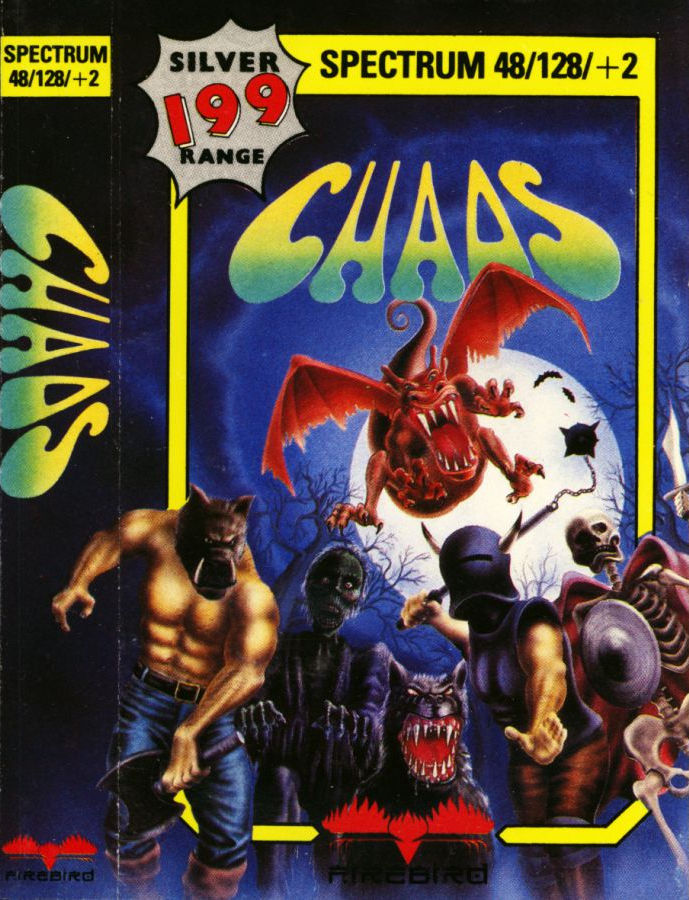
We last left Julian Gollop in late 1984, shortly after his departure from Red Shift. Around June of the same year, Red Shift’s co-founder Stanley Gee had fumbled his negotiation roll with his co-founders, and they left the company to found the SLUG co-operative. For his part, Julian Gollop was only distantly aware of the politics, and everything indicates he stayed around for a few extra months (Islandia and the final version of Time Lords were released around October). Still, in the end he left like the others: the pay was meagre anyway (£50 a month and no royalties for his games) and in September 1984 he started his first year at the London School of Economics (LSE) as a sociology major.
Earlier in 1981, before Red Shift was even a thing, Gollop had designed a game that would soon become a sensation in his close group of siblings and friends: Wizard Wars. On his defunct blog, Gollop explains that he started working on Wizard Wars after seeing people playing Game Workshop’s Warlock in the game club of his school back in 1981. Gollop never actually played Warlock, but seeing it in action was enough and soon with the help of his grandfather’s typewriter and the artistic talents of all siblings, the first creature cards of Wizard Wars were born:
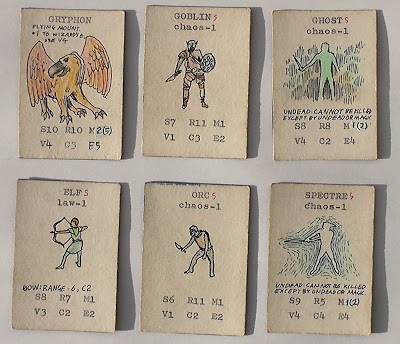
Most of the systems of what would become Chaos were already in Wizard Wars: the arena shifting toward chaos or law, success odds when casting a spell, Manoeuvre tests to escape melee, ranged attacks, undead who are immune to non-magical/undead attacks. Wizard Wars also had wizards with different stats, and non-creature spells:
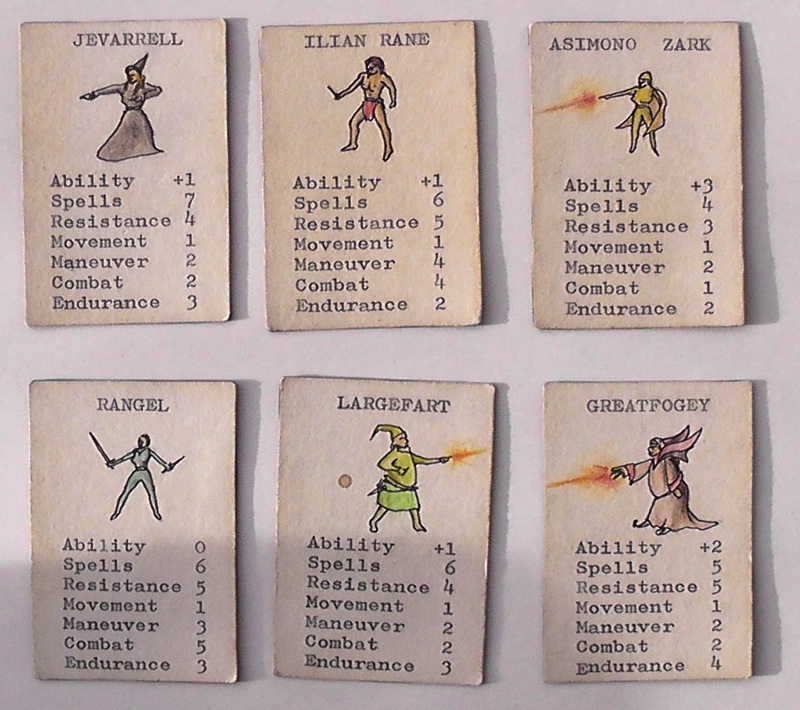
A few spells from Wizard Wars did not make it to Chaos, but the key difference between Wizard Wars and its computer version are the illusions, obviously impracticable in a board game. Presumably, this allowed to rebalance the strongest creatures like the dragons, though in the paper version they were already powerful, being able to cast their own spells!
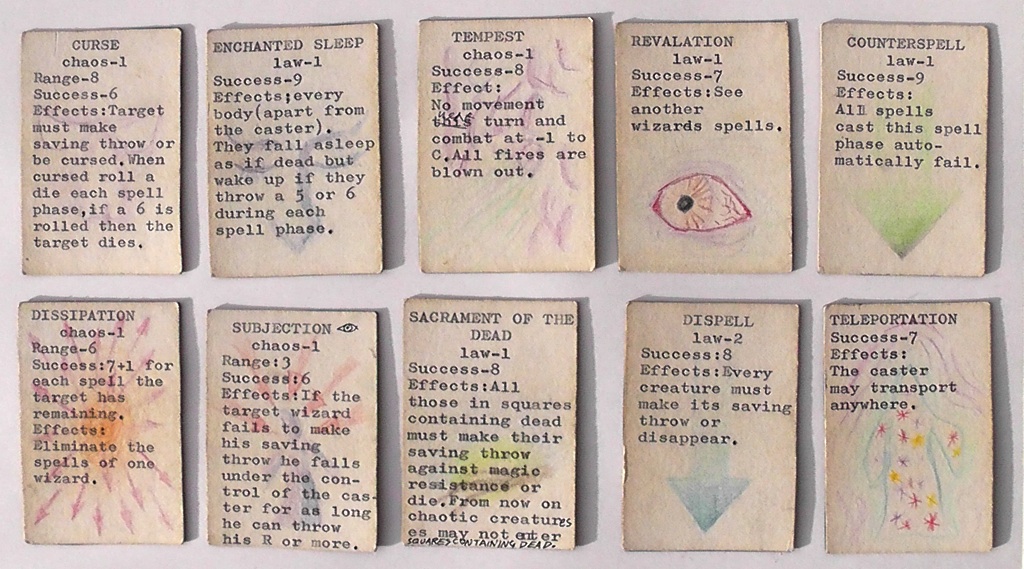

Given both the success and the relative simplicity of Wizard Wars in Gollop’s little tribe of friends and family, the Greene brothers earmarked it for a port. In 1982, immediately after finishing the computer version of Time Lords (the ugly Excel-looking one), the Greene brothers requested Gollop’s authorization to port it. This BBC Micro BASIC version, to which Gollop directly contributed, was renamed Chaos: The Battle of Wizards. Unfortunately, the three eager developers were still extremely junior and the game more challenging to port than expected. While the game eventually kind of worked, it was too crude to be released: the graphics were awful (“each creature was represented by a block of 4 letters”, Gollop remembers) and the game was clunky. Granted, this was also the case of the first Time Lords, and it still got released – but no such luck for the BBC Micro Chaos.
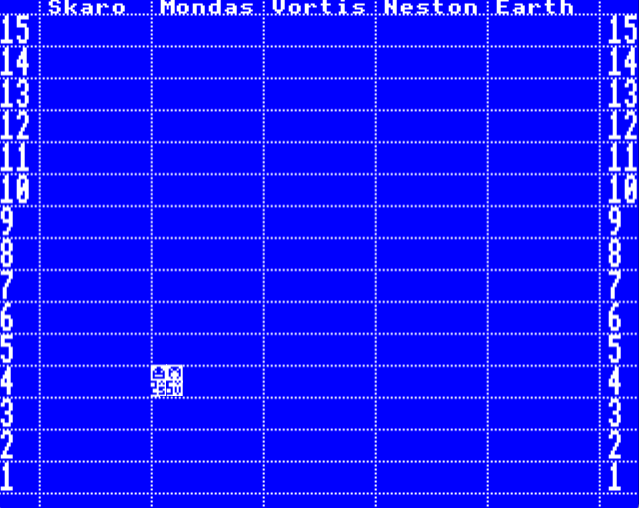
After the success of Rebelstar Raiders and with his growing coding experience, Gollop reckoned it was time to learn to make games with Z80 Assembly. Wizard Wars/Chaos seemed the perfect candidate for such a move. Chaos was started when Gollop was still at Red Shift, but of course the game was still a work-in-progress by the time he left the company, and Gollop needed a publisher. Well aware that he should be looking for a royalty deal, he turned to his SLUG friends for help.
The SLUG founders had left Red Shift with a great relationship with Games Workshop thanks to the success of Apocalypse and their own work-in-progress code for another port: Battlecars. Games Workshop also gave them early on yet another project: a port of Talisman. SLUG was a co-operative of developers, not publishers, and it did not even have an office. So when SLUG received Gollop’s plea for help, they naturally turned to the only publisher they knew: Games Workshop. Since Games Workshop had the know-how and the network, could they publish the game of their young up-and-coming developer?
Just like that, Chaos was eventually released around April 1985, ended up as being the only game published by Games Workshop that was not a port of one of their board games.
Ratings and Reviews

Chaos byJulian Gollop, first published by Games Workshop
First release: April 1985 on ZX Spectrum
Genre: Single Unit Tactics
Average duration of a campaign : 5 minutes per wizard in the arena (if not killed early)
Total time played : 5 hours
AAR: Here
Complexity: Easy (1/5)
Final Rating: Three stars
Ranking at the time of review: 10/133
A. Presentation: Adequate. For an 8-bit game, I am impressed: all units have their animation and even a specific body when dead, equipment changes how the wizards look, and their death is properly explosive. It’s still not great, but by 1985 standards it’s good.

B. UI, Clarity of rules and outcomes: Poor. The game is easy to use and allows you to check stats at all times – too bad that there are no explanations in the manual on what “manoeuvre” or “ability” are or how combats are resolved.
The choice of not colour-coding summons can make the game hard to read, especially when there are a lot of wizards around. The issue is mitigated by a key to quickly show who controls what, but still. Finally, Chaos is not able to show several pieces of equipment on the same wizards (if you have a magic sword and a magic bow, it will only show the last one you equipped), nor to show wizards mounting creatures (only the creature is shown). It can make the situation, like the one in the screenshot above where 4 different creatures are mounted, confusing to say the least.
C. Systems: Quite good. Chaos is deceptively simple: each player starts with a random set of spells and he or she can cast one per turn (or none at all). Spells have a success chance depending on the power of the spell and the alignment of the spell (law or chaos) compared to the one of the arena. Direct attack spells must also beat their target’s magic resistance by rolling 1D10 above it, else the spell fails. Alternatively, wizards can summon their creatures as illusions with 100% success rate, but an illusion can be dispelled with 100% success rate by “Disbelieve”, the only spell available to all wizards as many times as they want.
Once the spells are cast, wizards and their summons can move and engage enemies. Combats are resolved by comparing the Combat value +1D10 of the attacker to the Defence value + 1D10 of the defender. If attack beats defence, then the defender is dead – there is no HP system. If not, the defender can attack when it is its turn to play, or it can try to move away by rolling 1D10 below its manoeuvre stats.
Units, in addition to their raw stats, have a few perks:
- Undead creatures can only be killed by undead creatures and magic attacks (including magic swords summoned by wizards),
- Flying creatures are of course extremely mobile and can “dive-attack” at range, without approaching their target,
- Mountable creatures can be mounted by a wizard, giving the latter protection (the mount is killed first), speed and sometimes flying ability!
- Finally, some creatures have a ranged attack in addition to their melee attack.
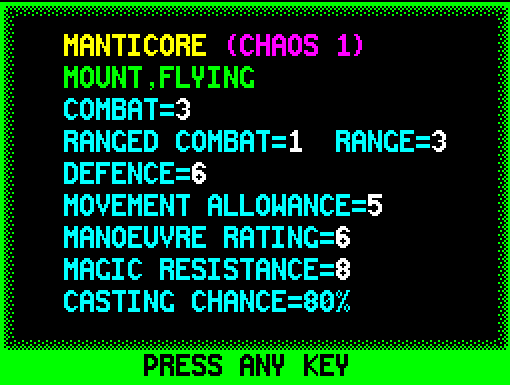
The key issue with Chaos is how random the game feels. As there is no HP system, a bad roll at any moment in the game is enough to kill you. Worse: you can be fried by a lightning bolt turn one before you even get to play. Or, later, when you are really invested in the game, you can get mauled by an illusionary dragon that you never had a chance to disbelieve because its owner played after you did. Similarly, all your efforts can be undone if you fail to resist a spell like “Decree”, which removes all your summons, leaving you alone, naked and soon dead. The DataDrivenGamer’s article lists a few other tricks that can break the game. It is not ideal in solitaire. These can be flat-out frustrating in multiplayer and they are so core to the game that they can’t even be house-ruled out!
D. Scenario design & balancing: Quite good. Chaos‘s replayability does not come from customization options (limited to the number and difficulty of computer-controlled Wizards) but from the randomness of your stats and the spells available to you and the other wizards, creating a relatively varied number of tactical situations. Sometimes you have a balanced deck, sometimes a lot of strong hard-to-summon creatures, giving you less raw power, sometimes few creatures but a lot of direct damage or arena-changing spells. Sometimes, you have strong stats and plenty of equipment spells and you should jump into fights yourself, sometimes you have terrible stats and your priority must be to never be in range of anything. Each set of stats and spells forces you to play differently. It is like playing Magic or Hearthstone with a deck you open before starting the match, which is in my opinion the best way to play those games.

There are some drawbacks to this randomisation. First Chaos can be incredibly unbalanced, particularly when some players have undead creatures and others have nothing to kill them, or when some players can fly and others can’t attack at range. This was probably acceptable in hotseat given how short a session is, but it can be frustrating in PBEM, even though of course PBEM did not exist in 1985. Against the computer, higher-level computer wizards can have insane stats, which makes the randomization of spells frustrating because you may lack spells or creatures that have any chance to harm your opponent – in my experience, beyond a certain point the higher the level the less interesting the game becomes as most of your creatures and spells become useless against wizards.
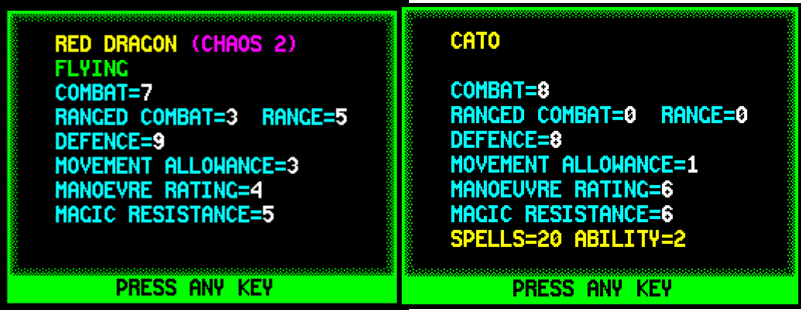
Finally, there are not enough spells in the spellbook for games with too many wizards: typically a player has between 10 and 16 spells, most of them creatures. Few of the other spells are going to allow tactical shenanigans or “fun” effects, so the typical endgame with 6 wizards is not the Battle of the Wizards but the Battle of the Summons, with the surviving players totally out of spells hoping the creatures they summoned during the battle prevail in the final melee – few tactics, a lot of dice rolls.
Overall, I found that I could largely mitigate those by playing at medium difficulty against 5 computer-controlled wizards instead of 7: the starting distance between the Wizards make turn 1 kills unlikely and the battle would usually not outlast my spellbook by much.
E. Did I make interesting decisions? Yes, though only as long as I had interesting spells to cast (or to postpone casting, which is also a decision).
F. Final Rating: Three stars. While I feel the game is weaker in multiplayer than Rebelstar Raiders (Rebelstar Raiders is unbalanced, Chaos is unbalanced and random), I enjoyed playing Chaos in solitaire more than in PBEM multiplayer. In solitaire, I saw a weird spellset as a challenge to play around rather than as an unfair issue to live with for the duration of the PBEM match, and I knew I could just launch a new game if I was one-shot by a dragon. This makes me rank Chaos above Rebelstar Raiders, and even above Galactic Gladiators, making it in 1985 one of the premier tactical experiences of the era.
Reception
Chaos received a throng of reviews, almost all of them between April and June 1985 – a sure sign that Games Workshop had sent a copy to all the major magazines instead of leaving reviews to a chance encounter by a journalist. The reviews are generally, but not unanimously, positive. In the two cases where Chaos is compared to Archon (Computer Gamer, April 1985 and Personal Computer News, 4th of May 1985), the former gives it 3 stars, against 4 for Archon, whereas the latter quips: “Chaos is a poor man’s Archon – it’s the nearest Spectrum owners can get“. That doesn’t make it a bad game though: “However, Chaos is great fun to play. It’s hampered by its board game feel, but the graphic detail and its addictive qualities will keep you coming back for months to come”.
The Crash review (May 1985) stands out. Derek Brewster warns that “I chiefly review adventure games” and it shows. Finding Chaos a “very complicated game“, he wonders why the game does not include a “status report for your wizard’s strength, hit points and magical resistance“, further complaining that “you don’t know how much damage has been done”. He also yearns for more missile attacks, like “the Magic Missile of Dungeons and Dragons” or “a fireball spell“. Nonetheless, “Chaos serves up something that has long been needed in the computer game world: a game which can be played by a great number of players […] whereby each player is actively involved“. Brewster gives the game a 8/10 rating, but the review reads like he wanted to give less, and he was called out in a letter to the editor more than one year later (October 1986).
The two mediocre reviews come from Your Spectrum (July 1985), with 3 reviewers giving respectively 2/5, 3/5 and 4/5 to the game, and the short-lived Sinclair Programs (May 1985) giving it a 66% rating. However, all other reviews I could find were at least positive, with the best one coming from Sinclair Users in March 1988: “To put it simply, Chaos is great, it’s colourful, it’s very easy to play and above all it’s probably the most fun you’ve had since you pickled your granny.” – maybe the latter was a fad in UK in the 80s?
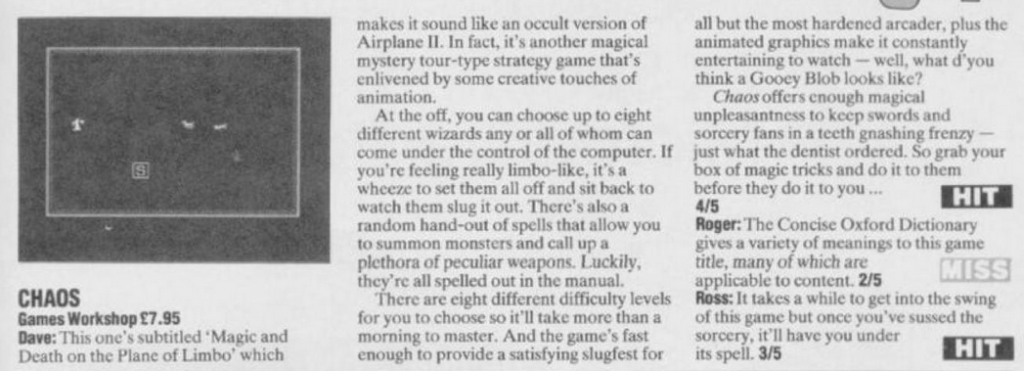
Chaos may have been a sleeper hit, as the game only reaches recurring prominence in letters to the wargame section of Crash from 1986 onward, with its editor Philippa Irving finally ending it in October 1987 “Have any of you out there ever played any game other than Chaos? Tips for Games Workshop’s apparently never-to-be-forgotten classic […] seem to account for half the mail Briefing receives but this month’s column is ABSOLUTELY THE LAST WORD on Chaos.”
Chaos sold well, but initially not for long, as Games Workshop closed its video game division sometime in 1986. Its remaining stock was heavily discounted, which of course impacted the royalties. Gollop however had a fall-back solution. His 1986 game Rebelstar had been published by Firebird Software and both had been, for once, satisfied by the relationship. Firebird asked Gollop whether he had more to publish and Gollop proposed Chaos. The offer was too good to pass for Firebird, and they released the game for £1.99 – the same price as Rebelstar. According to Gollop, it sold very well again. The game would be published three more times: once in 1991 by Gollop’s own company Mythos Games, as a part of the Rebelstar collection (the 3 Rebelstar games, Chaos and Nebula), and twice by Your Sinclair (1990, 1993) as cassettes embedded directly with the magazine. The first time, it allowed Gollop to advertise its sequel Lords of Chaos; the second time – well – Your Sinclair needed a game and Chaos was back by popular demand.
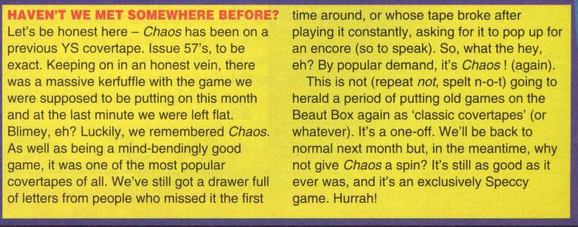
That was 8 years after the initial release, and Chaos felt almost as fresh as on day one. With the exception of Star Trek and Empire, I don’t think any game covered so far in this blog had such a lifespan. This is a testament to the quality of the game, regularly ending up in “top Spectrum games” lists, for instance in the last issue of Your Sinclair in September 1993 [5th position], which included nothing less than a full-fledged 7-player AAR of Chaos!
Well, that’s all for Chaos, but we are not done yet with Red Shift content! We’ve seen their best, soon we’ll see the rest.
6 Comments
Huzzah! Largefart is a rather unfortunate name for a wizard.
Chaos is great fun but is chaotic in nature. There was a later port of Archon to the ZX Spectrum, and Archon 2. Chaos is more fun I think. Archon wasn’t strategic, the combats were annoying, and the sequel had a spell that forced a sort of “golden goal” match.
Shadow Forest! Magic Wood! Dark Citadel! Magic Castle! Gooey Blob!
Marvellous.
I have a lot of fond memories of playing Chaos, on my 48k ZX Spectrum and on emulators, easily my favourite Spectrum game. The sheer randomness (chaos, even) can be an issue but mostly for the better I think, the game is at its best when there’s a bunch of wizards running about casting whatever they can come up with, you can’t remember which of your monsters was an illusion, and a Gooey Blob has taken over half the screen.
This game should have an extra “Build Your Own Spellbook” mode, on top of the random one. That would allow you to try different tactics. You mention Magic the Gathering pre-built decks, but those aren’t random; they’re made of cards specifically chosen because they work together.
I was thinking “Limited” formats in Magic or “Arena” in Hearthstone, where you build a deck from a very limited choice of cards (in Magic you would open boosters/packs just before the match, in Hearthstone it’s “choose one out of 3 cards” 40 times in a row). These are my favourite types of mode.
I think all formats (“constructed”, “limited”, “pure randomness”) suit Chaos, I wish I could choose which one to use indeed – particularly if I had seen the stats of my wizard beforehand. OTOH, enforcing pure randomness keeps the game simple and really forces you in situation you would not have been if you had a choice in format (because, let’s be honest, most of your games would have been in “limited” if you had the choice. Sometimes, fewer choices for the player is good.
Right, you mean the “Draft” format.
This is a late comment to say that my life has been much better for having had Chaos in it. Yes, its unbalanced. Gloriously so. The title of the game gives it away. If you don’t have a story about winning a game by casting your last desperate 10% dragon spell, you’ve not really lived.